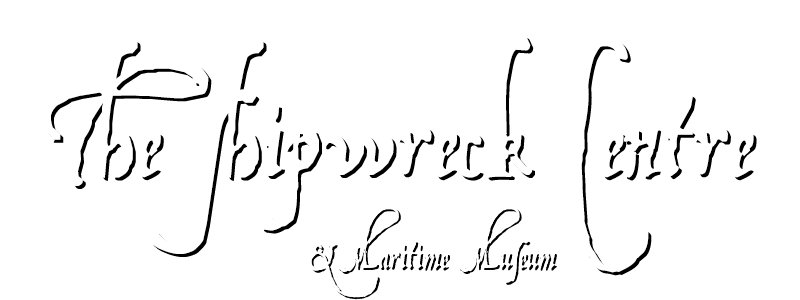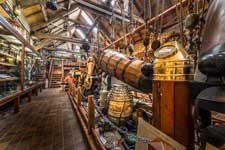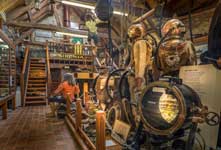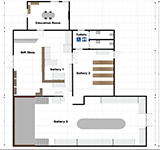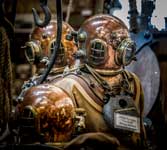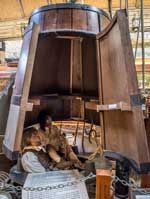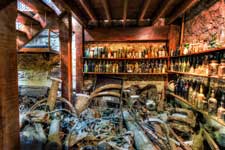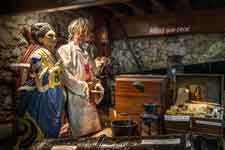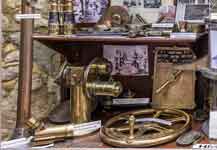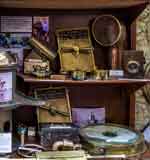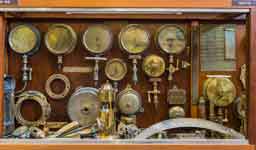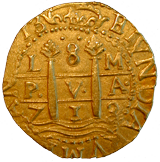Our exhibitions
Gallery 1
Focusing on pre-history, the history of underwater exploration and our temporary exhibitions. The exhibition about Bouldnor Cliff, a 8000 year old site, now submerged just outside Isle of Wight tells us the story of early settlements on what we now call Isle of Wight
Gallery 2
Designed to offer a comfortable and very popular museum guide video experience ("Walkaround Tour of the Shipwreck Centre"). The 40 minute show presented by Martin Woodward leads the visitor though the story of the museum and includes video clips from wreck discoveries and past adventures.
Gallery 3
Our main gallery houses an enormous variety of maritime history. The majority of our exhibitions in Gallery 3 are permanent and include;
SS Mendi 1917
Our SS Mendi display is one of our visitors' favourite but comes with a tragic story. The ship was chartered as a troopship during the First World War when on 21 February 1917 while on route to Le Havre in northern France it collided with the large cargo steamship 'Darro'. The sinking was a major loss of life for the South African military who lost 646 people and was one of the 20th century's worst maritime disasters in UK waters. The museum respectfully displays items recovered from the site and is working with the South African government to honour the victims.
Siebe Gorman early diving equipment.
The famous Deane brothers invented the first effective diving helmet and dress, although there were several earlier designs by other people over the centuries. They went on to carry out a successful salvage in 1829 on the wreck of the East India ship 'Carn Brea Castle' off the Isle of Wight. The Deane brothers then went to a German born engineer named Augustus Siebe to improve their helmet design. His company eventually became the famous Siebe Gorman Company in 1870, which manufactured diving helmets, pumps and other equipment. The helmet design changed little over many years, even remaining similar up until the 1950s, when other more modern forms of diving equipment gradually superseded the old helmet equipment. Siebe Gorman existed as a company until the late 1990s.
The Lethbridge Barrel
This fascinating diving barrel was invented in 1715 by one of the earliest pioneering divers, John Lethbridge from Devonshire. His early experiments were carried out in a pond in his orchard in Devon. It was later reported in the Weekly Journal on Saturday 2nd April 1720 that he was "let down into the Thames in an engine and kept underwater half an hour, taking with him meat and drink and having his dinner underwater". The barrel had to be brought up at regular intervals to replenish the air, otherwise Lethbridge would have become unconscious with the build-up of carbon dioxide. He went on to successfully salvage many shipwrecks over the following years.
The Halley Diving Bell
Diving 'bells' were also developed for underwater work, following on from the earlier diving barrels. The concept of the diving bell was first invented and used in 1535, but Aristotle had described a similar device in the 4th Century BC. Although other designs came along in the 1600s, Dr Halley (of Comet fame) built a working bell in 1691 and our Halley bell is a replica of his design.
The 'Seabed Scene'
A display in the left corner under the stairs depicts a seabed scene showing hundreds of items recovered from shipwrecks. The difference between this and the rest of the displays in the museum is that all these items have been left in their "as found" condition to give the visitor an idea of how things look in their raw state on a wreck-site. The cleaning process of artefacts from underwater is a lengthy one, as all the marine growth has to be carefully removed before the items can then be restored to their original condition.
The "Gun Deck"
Under the stairs on the right hand side is a display showing a section of a typical gun deck on an early man-of-war sailing ship of the 1700s era. The ship's surgeon had an arduous time coping with all the injuries sustained by crewmen in a typical sea battle involving cannon fire. He worked in a very confined space and with limited equipment, as can be seen by the minimal height of the deckhead.
HMS 'A1'
'A1' was the Royal Navy's first "all British" designed and built submarine at the beginning of the 20th Century. She was taking part in a naval exercise off the Nab Tower near Portsmouth in 1904 when she was run down and sunk by the liner 'Berwick Castle'. The crew all perished in the accident, but the submarine was soon relocated and raised so that the crew could be given a proper burial. The submarine was repaired and put back into service for several years, then later used in unmanned underwater experiments before eventually being lost again in 1911 in the Solent. She then lay undiscovered until 1989 when she was found by accident off Chichester by a Selsey fisherman. A project was then set up to recover and restore the beautiful artefacts you can see in our HMS 'A1' displays.
HMS P12, HMS 'Boxer' and HMS 'Velox'
These three Royal Navy ships were all lost in Isle of Wight waters during World War 1. The stories of the ships and how they were lost are told in these displays, along with the beautifully restored items recovered from the shipwrecks.
Navigational instruments and coins
The museum displays various navigational instruments such as the astrolabe, octant and the later sextant. Ship's clocks, telescopes and compasses are also included in this fascinating display of navigation through the ages. Included are also the old pirate currency "Pieces of Eight" and "Gold Doubloons" recovered from various shipwrecks.
